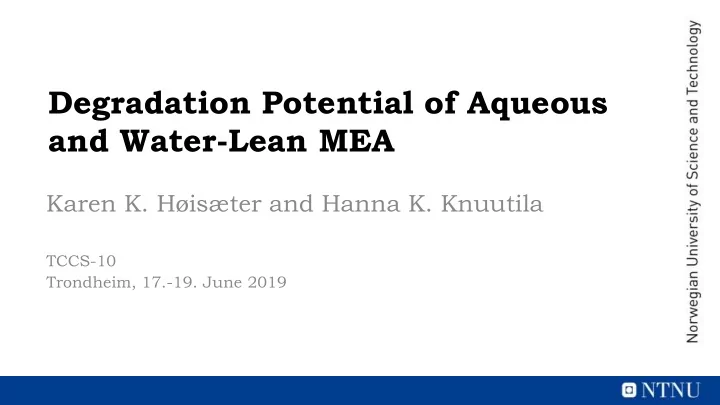

Degradation Potential of Aqueous and Water-Lean MEA Karen K. Høisæter and Hanna K. Knuutila TCCS-10 Trondheim, 17.-19. June 2019
Outline Introduction Experimental Results Conclusion Solution preparation MEA + water Further work Methodology MEA + TEG/water 2
1. Introduction Solvent degradation Thermal degradation With CO 2 Without CO 2 3
1. Introduction Solvent degradation Primary and secondary amines Carbamate polymerization Degradation dependent on: - Temperature - CO 2 loading - Initial MEA concentration Tertiary amines Other mechanisms Davies et al., 2009 4
1. Introduction Motivation Aqueous Water lean amines solvents Amine 30-40wt% and amine organic solvents 5
2. Experimental Solution preparation Triethylene glycol (TEG) CO 2 MEA Water TEG Water CO 2 MEA
2. Experimental Methodology Two parallels Stainless Placed in • • Experiments 8 g solution steel an oven extracted each • Flushed with N 2 ran for 5 weeks cylinders at 135°C week
2. Experimental Analytical methods • Amine titration Remaining amine concentration • TOC CO 2 concentration • ICP-MS Metals in solutions • LC-MS degradation products 8
3. Results Thermal degradation of MEA in water • Varying ratios of MEA in water • Previously thought to increase degradation: – Increased loading – Increased MEA concentration α = 0.5 9
3. Results Degradation results of MEA in water 1.00 0.95 Relative amount of amine MEA in water 0.90 100 mol% 0.85 8 mol% 0.80 0.75 0.70 0.65 0 1 2 3 4 5 Weeks Different ratios of MEA in water, loaded with 1.77 molCO 2 /kg solution 10
3. Results Degradation results of MEA in water 1.00 0.95 Δ 1.1 mol/kg Relative amount of amine Δ 0.85 mol/kg MEA in water Δ 0.81 mol/kg 0.90 100 mol% Δ 0.93 mol/kg 73 mol% 0.85 41 mol% 0.80 23 mol% 11 mol% 0.75 Δ 1.1 mol/kg 8 mol% Δ 1.0 mol/kg 0.70 0.65 0 1 2 3 4 5 Weeks Different ratios of MEA in water, loaded with 1.77 molCO 2 /kg solution 11
3. Results Degradation results of MEA in water/TEG • Varying ratios of TEG in water, and constantly 5 Molal MEA ( α = 0.5) • Triethylene glycol, TEG: 12
3. Results Degradation results of MEA in water/TEG 1.0 Relative amount of amine 0.9 0.8 TEG in water 0.7 0 mol% 100 mol% 0.6 0.5 0.4 0 1 2 3 4 5 Week Different ratios of TEG in water, with 5 Molal loaded MEA 13
3. Results Degradation results of MEA in water/TEG 1.0 Relative amount of amine TEG in water 0.9 0 mol% 0.8 5 mol% 0.7 20 mol% 50 mol% 0.6 80 mol% 0.5 100 mol% 0.4 0 1 2 3 4 5 Week Different ratios of TEG in water, with 5 Molal loaded MEA 14
3. Results Degradation results of MEA in water/TEG Water stabilizes protons needed for carbamate polymerization reaction pKa 14.06 TEG leads in different degradation mechanism pKa 14.00 Degradation products of TEG enhances the carbamate polymerization reaction 15
4. Conclusions • MEA and water concentrations do not seem to influence thermal degradation significantly. • Replacing water with TEG results in higher thermal degradation of MEA. • Further analysis needs to be conducted to look into the effect of TEG on the degradation of MEA. 16
4. Conclusions Further work MEA in water, with constant absolute amount of CO 2 MEA in different ratios of 0-100% TEG and water Various amines in 0% and 50% TEG in water Various organic solvents, both pure and with 5 Molal MEA (loaded). 17
Thank you for the attention! Questions? 18
Recommend
More recommend